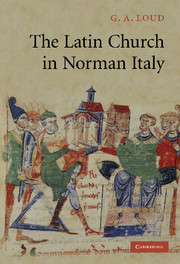Book contents
- Frontmatter
- Contents
- Preface
- List of maps
- List of abbreviations
- Map I Southern Italy: archbishoprics and principal bishoprics
- Map II Southern Italy: abbeys
- Map III The dioceses of Sicily in the late twelfth century
- Map IV The dioceses of the Terra di Bari
- Map V The dioceses of the Terra di Lavoro
- Introduction
- 1 The Church in southern Italy before the Normans
- 2 The Church and the Norman conquest
- 3 The papacy and the rulers of southern Italy
- 4 The papacy and the Church in southern Italy
- 5 The kings of Sicily and the Church
- 6 The Church and military obligation
- 7 The secular Church
- 8 Monasticism
- 9 Latins, Greeks and non-Christians
- Conclusion
- Appendices
- Bibliography
- Index
3 - The papacy and the rulers of southern Italy
Published online by Cambridge University Press: 04 May 2010
- Frontmatter
- Contents
- Preface
- List of maps
- List of abbreviations
- Map I Southern Italy: archbishoprics and principal bishoprics
- Map II Southern Italy: abbeys
- Map III The dioceses of Sicily in the late twelfth century
- Map IV The dioceses of the Terra di Bari
- Map V The dioceses of the Terra di Lavoro
- Introduction
- 1 The Church in southern Italy before the Normans
- 2 The Church and the Norman conquest
- 3 The papacy and the rulers of southern Italy
- 4 The papacy and the Church in southern Italy
- 5 The kings of Sicily and the Church
- 6 The Church and military obligation
- 7 The secular Church
- 8 Monasticism
- 9 Latins, Greeks and non-Christians
- Conclusion
- Appendices
- Bibliography
- Index
Summary
While there had always been some contact between the papacy and south Italian rulers, until the pontificate of Leo IX this had been intermittent and infrequent. In the years before 915 the popes had made some efforts to persuade the local rulers of the south to combine together against the Muslims, but thereafter there was little direct contact, with the exception of John XIII's visit to Capua in 966. In the wake of this visit there was, however, slightly more communication with south Italian churchmen than there had been hitherto. The creation of the new archbishoprics at Capua, Benevento and Salerno from 966 onwards led to some granting of privileges, confirming the rights and claims of these sees, and south Italian ecclesiastics were occasionally to be found at Rome. Thus the archbishop of Capua and one of his subordinate bishops had attended a Roman synod in 999, and the abbots of both Montecassino and St Vincent on Volturno, and probably also the archbishop of Benevento, attended the imperial coronation of the Emperor Henry II in 1014. However, such contacts were still exceptional, not routine, and were anyway limited to the higher clergy of the Lombard principalities of Campania. There was virtually no communication between the popes and the rest of the region. The early medieval papacy was an essentially passive institution that reigned over the Church as its titular leader rather than ruled it in any meaningful governmental sense.
- Type
- Chapter
- Information
- The Latin Church in Norman Italy , pp. 135 - 180Publisher: Cambridge University PressPrint publication year: 2007

